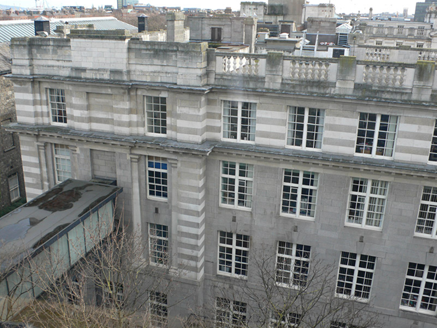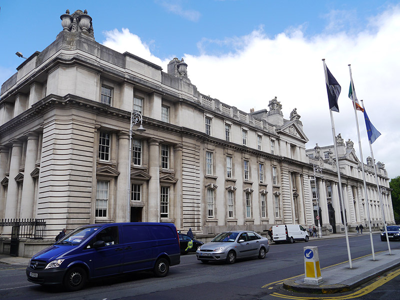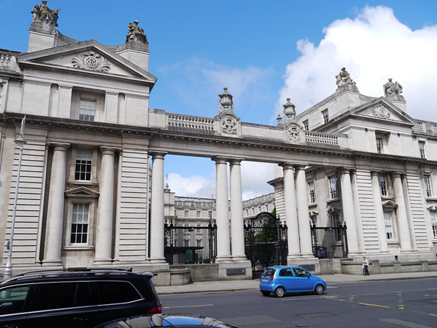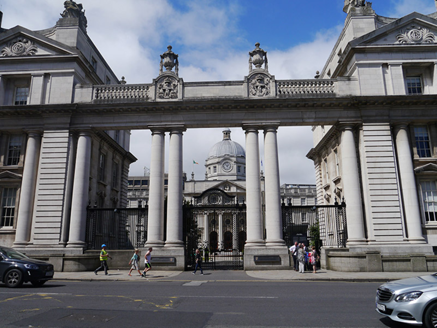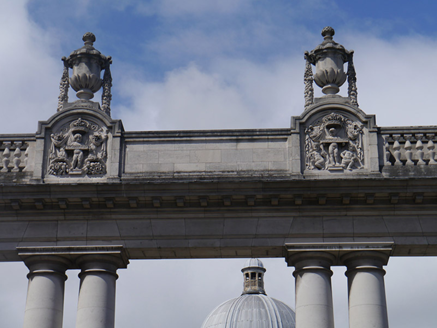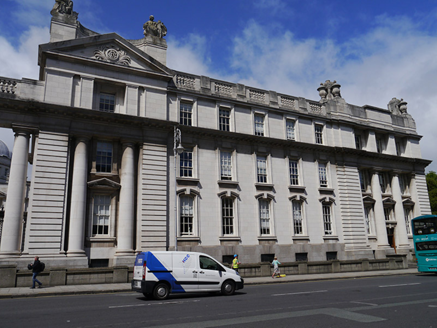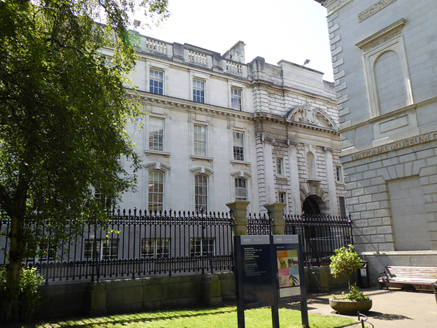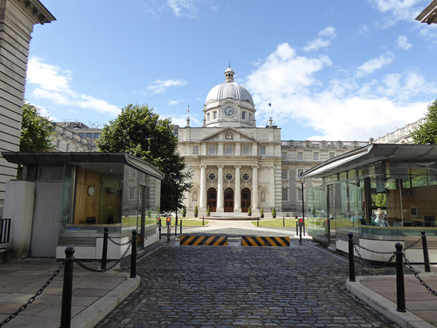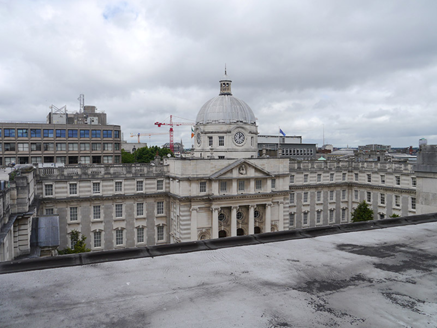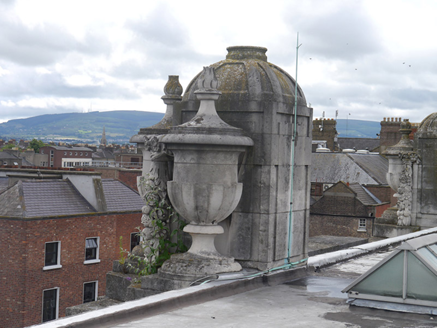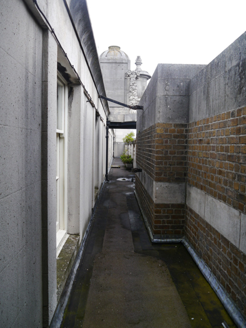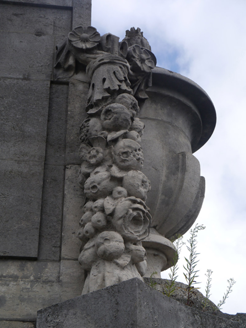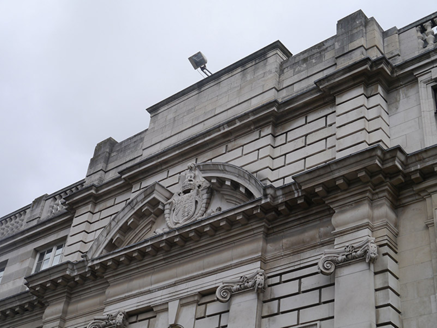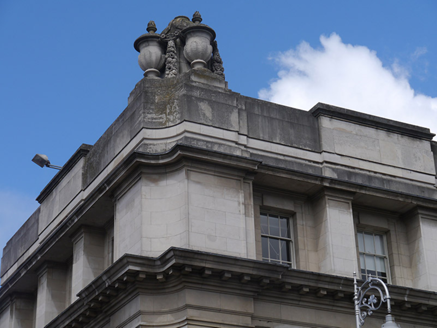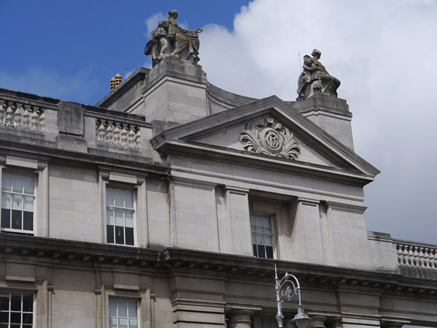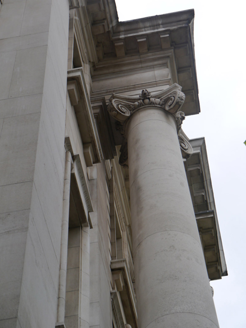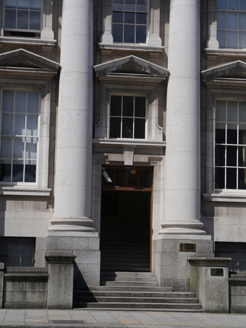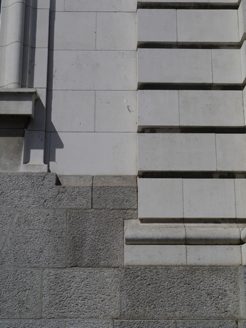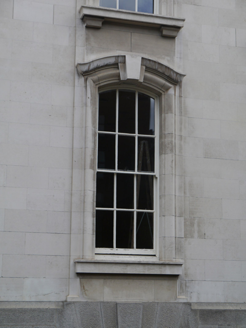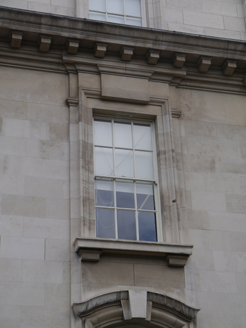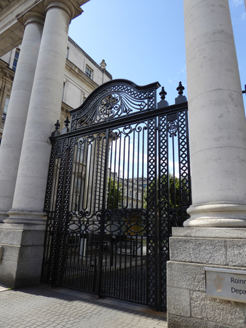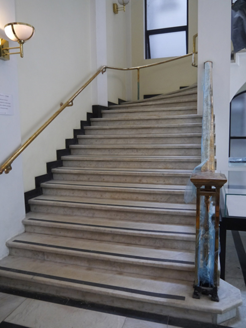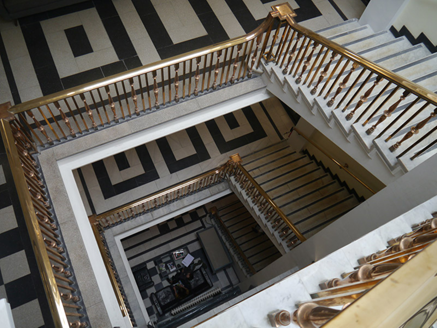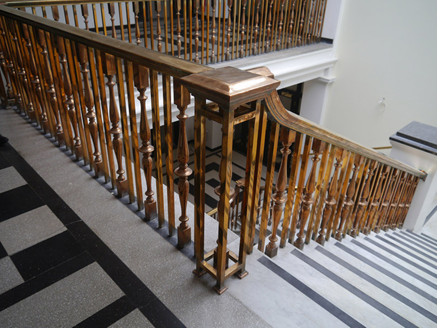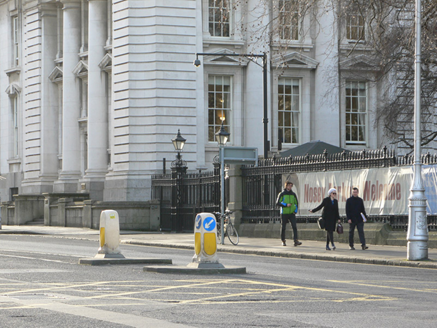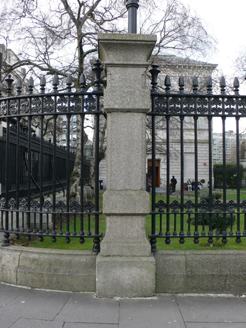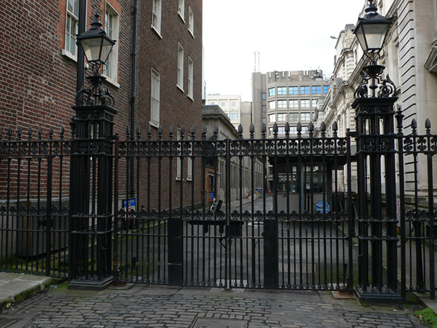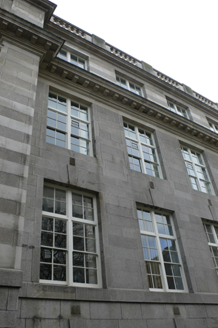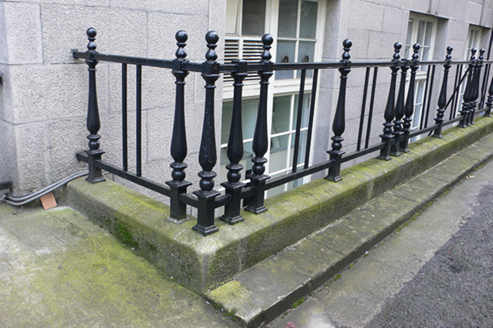Survey Data
Reg No
50100242
Rating
National
Categories of Special Interest
Architectural, Artistic, Social
Previous Name
Royal College of Sciences
Original Use
College
In Use As
Office
Date
1900 - 1925
Coordinates
316378, 233504
Date Recorded
28/07/2016
Date Updated
--/--/--
Description
Freestanding symmetrical three-storey quadrangular building, built 1904-1922, as college and government offices, facing east, and having hidden attic and raised basement, monumental entrance screen to middle of front (east) side, and pedimented portico and two-tier dome to western east-facing block. Rear parts reordered for use as government offices 1989-91. Front (street) elevation comprises three-bay entrance screen of Doric columns (flanking pairs to middle, further pilasters to outer) on dressed granite pedestals and supporting entablature with plain frieze and dentillated heavy moulded cornice that runs length of exterior of entire quadrangle and divides second floor form lower floors; parapet divided by carved cartouches depicting Agriculture and Local Government, topped by garlanded urns, and with heavy cast-iron railings between columns and having decorative vertical panels to outer sides with ornate finials. Similar panels flank double-leaf vehicular gate with curvilinear screen above, whole having ornate detailing. Screen flanked by slightly projecting single-bay breakfronts, each of which is distyle in antis with triangular pediment and having royal monograms of Edward VII and George V to tympana, these projections in turn flanked by five recessed bays and these in turn again by corner pavilions of three bays to external elevations and are also distyle-in-antis, but have simple pediments. North and south outer elevations are of twenty-one bays, each having slightly projecting three-bay breakfront to centre with open-topped pediment having royal crest and crown, Ionic pilasters flanking bays, central round-arch through-way with blind niche above having cornice with keystone and moulded sill over scrolled corbel; flanked by six recessed bays and corner pavilions. West elevation is of twenty-seven bays and four storeys, comprising five-bay projection with single-bay short sides, eight-bay recesses and corner pavilions. Within quadrangle all blocks are of four storeys; east block has four-bay elevations flanking projections, innermost bays being narrower; north and south blocks have five bays flanking breakfronts and west block has six bays flanking domed block, latter having two-bay short sides and three-bay breakfront with prostyle tetrastyle Ionic portico with pediment having statue of Science to tympanum within round-headed recess, and parapet having urns, portico flanked to ground floor by niches containing statues of Rowan Hamilton and Robert Boyle. Flat roofs throughout with leadwork, dome having octagonal plan, with clock to cardinal points in segmental aediculed surrounds, and openwork lantern with colonnade and finial. Some lanterns elsewhere to roof. Portland stone parapets, generally balustraded; east elevation has solid parapets over pavilion end bays, topped by pairs of clustered urns. Pedimented bays flanking entrance screen have concave pediments with statues of female allegorical figures. Concealed rainwater goods, and with cast-iron downpipes to attic. Dressed granite walling to basement with Portland stone facing above, having Portland stone dressings throughout; alternate granite and Portland stone banding to interior elevations at second floor and framing centrepiece. Channelled rustication to external elevations of ground and first floors of pavilions and pedimented bays of front elevation. Channelled walling to breakfronts to north and south blocks. Panelled piers to top floor level, framing recessed window openings. Glazed tiled walling to concealed internal light-wells to north and south blocks. Square-headed window openings to basement, first and second floors, and generally segmental-headed to ground floor, except for feature bays which are square-headed and pedimented. Basement window openings have raised keystones, but are otherwise plainly detailed. Architrave surrounds to other floors, with moulded stone sills on corbels to ground and first floors, and with keystones to ground floor. Timber sliding sash windows, six-over-six pane to ground and first floors, three-over-six pane to top floor and double four-over-four pane to basement, except for rear elevations of west block and north and south blocks to west of breakfronts, which have casement windows; recessed bays to west part of south elevation and rear elevation of domed block have double-height windows. Front elevation of west block has three oculus windows to first floor with moulded surrounds, keystones, pivot windows and vegetal ornament; ground floor has round-headed entrance openings with moulded cornices and triple keystones to moulded archivolts, and double-leaf half-glazed timber doors with glazed over-doors. Portico approached by limestone steps. Square-headed entrances to north and south wings located at pavilion ends of east elevation, each having architrave and pediment similar to window openings, six-pane overlight and double-leaf twelve-panel polished timber door with bronze furniture, approached by flight of seven granite steps. Basement area to street enclosed by solid granite wall with saddle-back copings and squat square-plan piers. carriage-archways to north and south blocks have vermiculated voussoirs and moulded imposts. Interior retains essential original layout and detailing. Plainly detailed offices accessed off axial corridors, diminishing in height from ground floor upwards. Geometric black and white terrazzo flooring, original panelled timber doors having timber latticed fanlights (also diminishing in height), moulded timber architraves having black stone outer banding. Open-well open-string cantilevered stone staircase with polished brass balustrade, handrail and newels. Meeting room and Minister's Office having plasterwork panels to walls, dado, coffered ceiling, and Ionic pilasters to window surrounds. Minister's Office has pedimented double-leaf door, green and white marble chimneypiece and timber flooring. Gateways, erected c. 1922, located outside northeast and southeast corners of quadrangle, each comprising double-leaf vehicular gate flanked by square-plan openwork cast-iron piers with scrolled brackets to top supporting lamps and flanked by pedestrian gates, latter to north-eastern gateway meets granite pier of gate screen to Natural History Museum/Leinster Lawn.
Appraisal
A grand and imposing quadrangular block built originally to be shared between the new Department of Agriculture and Technical Instruction and Local Government Board, and the Royal College of Science, to designs by Aston Webb with assistance from Cork architect Thomas Manly Deane. Its composition is loosely based on Gandon’s Custom House. Grand Manner Edwardian Baroque at its most extravagant, and a late example of academic classicism on this scale, reflecting, in Casey's words, 'the swan-song of British administration in Ireland.' The foundation stone was laid by King Edward VII in 1904, and the partially completed building was opened by King George V in 1911, although it was not actually completed until 1922. Materials were an important consideration in its execution, with officials insisting that four-fifths of the materials used would be Irish. Albert Power was responsible for the fine statues representing Science, and the Irish scientists Rowan Hamilton and Robert Boyle adorning the entrance portico. Its monumental nature is emphasized by the strong horizontal line provided by the heavy cornice, the use of Giant Order columns and pilasters and by the gigantic gate screen. The Portland stone facing reflects its status and the use of pediments and the classical architraves to the windows and doorways, and the giant urns and statuary to the roof-line, add fine, eye-catching detail. The interiors, while functional, exemplify early twentieth-century craftsmanship. The staircases display high-quality craftsmanship in marble and brass, windows have classical surrounds and there is fine joinery to doorways and pleasing polychrome tiled floors to corridors. The cast-iron flanking gateways contribute to the monumental character of the building and provide a visual connection with the railings and gates to Leinster Lawn.
